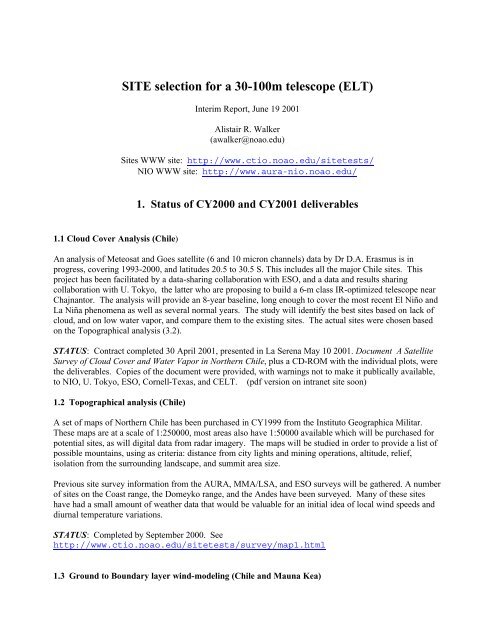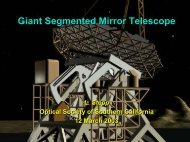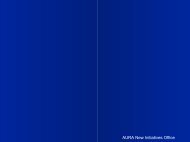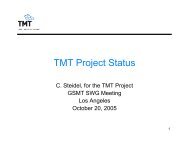SITE selection for a 30-100m telescope (ELT) - GSMT
SITE selection for a 30-100m telescope (ELT) - GSMT
SITE selection for a 30-100m telescope (ELT) - GSMT
You also want an ePaper? Increase the reach of your titles
YUMPU automatically turns print PDFs into web optimized ePapers that Google loves.
<strong>SITE</strong> <strong>selection</strong> <strong>for</strong> a <strong>30</strong>-<strong>100m</strong> <strong>telescope</strong> (<strong>ELT</strong>)<br />
Interim Report, June 19 2001<br />
Alistair R. Walker<br />
(awalker@noao.edu)<br />
Sites WWW site: http://www.ctio.noao.edu/sitetests/<br />
NIO WWW site: http://www.aura-nio.noao.edu/<br />
1. Status of CY2000 and CY2001 deliverables<br />
1.1 Cloud Cover Analysis (Chile)<br />
An analysis of Meteosat and Goes satellite (6 and 10 micron channels) data by Dr D.A. Erasmus is in<br />
progress, covering 1993-2000, and latitudes 20.5 to <strong>30</strong>.5 S. This includes all the major Chile sites. This<br />
project has been facilitated by a data-sharing collaboration with ESO, and a data and results sharing<br />
collaboration with U. Tokyo, the latter who are proposing to build a 6-m class IR-optimized <strong>telescope</strong> near<br />
Chajnantor. The analysis will provide an 8-year baseline, long enough to cover the most recent El Niño and<br />
La Niña phenomena as well as several normal years. The study will identify the best sites based on lack of<br />
cloud, and on low water vapor, and compare them to the existing sites. The actual sites were chosen based<br />
on the Topographical analysis (3.2).<br />
STATUS: Contract completed <strong>30</strong> April 2001, presented in La Serena May 10 2001. Document A Satellite<br />
Survey of Cloud Cover and Water Vapor in Northern Chile, plus a CD-ROM with the individual plots, were<br />
the deliverables. Copies of the document were provided, with warnings not to make it publically available,<br />
to NIO, U. Tokyo, ESO, Cornell-Texas, and C<strong>ELT</strong>. (pdf version on intranet site soon)<br />
1.2 Topographical analysis (Chile)<br />
A set of maps of Northern Chile has been purchased in CY1999 from the Instituto Geographica Militar.<br />
These maps are at a scale of 1:250000, most areas also have 1:50000 available which will be purchased <strong>for</strong><br />
potential sites, as will digital data from radar imagery. The maps will be studied in order to provide a list of<br />
possible mountains, using as criteria: distance from city lights and mining operations, altitude, relief,<br />
isolation from the surrounding landscape, and summit area size.<br />
Previous site survey in<strong>for</strong>mation from the AURA, MMA/LSA, and ESO surveys will be gathered. A number<br />
of sites on the Coast range, the Domeyko range, and the Andes have been surveyed. Many of these sites<br />
have had a small amount of weather data that would be valuable <strong>for</strong> an initial idea of local wind speeds and<br />
diurnal temperature variations.<br />
STATUS: Completed by September 2000. See<br />
http://www.ctio.noao.edu/sitetests/survey/map1.html<br />
1.3 Ground to Boundary layer wind-modeling (Chile and Mauna Kea)
A NOAO-funded wind-flow modeling analysis of Chajnantor sites <strong>for</strong> Cornell. by Dr D. De Young (NOAO)<br />
will serve to characterize the wind flow patterns <strong>for</strong> the high altitude sites chosen by Cornell as possible<br />
locations <strong>for</strong> a large IR-optimized <strong>telescope</strong>. These analyses, based on radar imagery, will be invaluable in<br />
our own evaluation of these sites <strong>for</strong> the <strong>ELT</strong>, and as a model <strong>for</strong> analyses of other sites. See De Young &<br />
Charles (A.J., 110, 3107, 1995).<br />
STATUS: This work has gone very slowly due to other calls on D De Young's time. After discussions in<br />
April 2000, the initial analysis of the Cornell-specified regions was re-scheduled to be completed by July-<br />
August 2001.<br />
An analysis of the Gemini site on Mauna Kea is contained in the above reference. A similar analysis could<br />
be carried out <strong>for</strong> the Mauna Kea <strong>ELT</strong> site.. Due to the large amounts of human and computer time needed<br />
<strong>for</strong> these analyses, it is feasible to analyze only a few sites in this way.<br />
STATUS: Dave De Young has indicated that he would be able to do an analysis of this site in September<br />
2001. The work should go quickly since the top of MK is already gridded at satisfactory resolution.<br />
1.4 Initial Survey (Chile)<br />
A ground and/or air visual survey of the final sites needs to be made, to ascertain access, structure, and<br />
proximity to any mining activity.<br />
STATUS: This activity is being led by Bob Blum and consist of two parts:<br />
(a) A weather station has been installed on the Honar ridge at 5400m altitude in the Chajnantor<br />
science preserve, in October 2000. This work is in collaboration with Cornell, and also serves<br />
as a test-bed <strong>for</strong> our site-testing equipment. During the initial set-up, a DIMM was successfully<br />
operated. See http://www.ctio.noao.edu/index.html<br />
(b) Via AOSS, Asesoria y Servicios de Ingenieria (ASI) have been asked to investigate the legal<br />
property and mineral rights status of two large regions containing six of the peaks determined to<br />
be the most promising according to PWV and lack of cloud. See<br />
http://www.ctio.noao.edu/org/sitetests/ss010.html<br />
1. 5 Atmosphere structure<br />
The <strong>ELT</strong> will be a <strong>telescope</strong> critically dependent on Adaptive Optics in order to achieve its science goals.<br />
This will require detailed knowledge of the heights and strengths of the turbulent layers in the atmosphere,<br />
and their variability on time-scales ranging from hours to months.<br />
The vertical structure of the atmosphere can be directly measured using SCIDAR (Vernin et al. 1990, Radio<br />
Sci. 25, 953). Generalized SCIDAR (gSCIDAR, Fuchs et al. 1994, Proc. SPIE Vol. 2222, 682) has extended<br />
the technique to also provide structure in<strong>for</strong>mation below 1000-m. SCIDAR characterization is normally run<br />
in campaign mode, generally by the U. Nice group, since it requires use of a special camera on an already<br />
existing <strong>telescope</strong> of at least 1-m aperture. This is inappropriate <strong>for</strong> an extensive site-testing campaign.<br />
It appears possible to built a compact and relatively inexpensive instrument that achieves similar results, and<br />
we will initiate such a project in CY2001. ESO is also procuring an identical instrument, designed by A.<br />
Tokovinin, now at CTIO. It would be ideal to test such an instrument on MK, since the MM5 model<br />
meteorological predictions <strong>for</strong> MK include CN2. Whether a SCIDAR run, and/or direct measurements
using balloons are also needed <strong>for</strong> calibration is tbd, this could be carried out either at MK or Cerro Tololo,<br />
in principle.<br />
The anticipated improvements to the model resulting from this direct comparison should then give<br />
confidence that it can predict the atmospheric structure realistically. The model, in the low verticalresolution<br />
mode used <strong>for</strong> <strong>for</strong>ecasting, provides an estimate <strong>for</strong> the integrated vertical turbulence, converted<br />
to a fwhm of a star image. The best way to compare this prediction to that actually observed is by use of a<br />
DIMM (Differential Image Motion Monitor, see<br />
http://www.astro.washington.edu/rest/dimm/index.html).<br />
STATUS: Procurement of Turbulence Profilometer, initiated Feb 2001, delivery Dec 2001 estimated.<br />
Project leader Andre Tokovinin. See<br />
http://www.ctio.noao.edu/org/arctr/profiler/index.html<br />
1.6 Sodium Layer measurements<br />
The Imperial College group is conducting a campaign, jointly funded by NOAO ($25K) and Gemini, on<br />
Cerro Tololo in 2001. CTIO is providing scientific and technical support, CTIO lead is Brooke Gregory.<br />
STATUS: Underway, final run scheduled <strong>for</strong> Feb 2002.<br />
1.7 Site Test equipment<br />
We have used the opportunity to upgrade or install equipment (such as a DIMM) that are useful <strong>for</strong> site<br />
monitoring work. The basic workhorse equipment is a well-equipped weather station, and a DIMM. A<br />
turbulence profilometer is discussed above. We are also procuring micro thermal sensors (also useful inside<br />
domes!), a dust particle meter, etc. Equipment purchase began in CY1999.<br />
STATUS: This work is being supervised by Hugo Schwarz. Three stand-alone weather stations with wind,<br />
humidity, solar flux and temperature sensors have been assembled and tested. In October 2000 one of the<br />
stations was installed on Cerro Honar, in the Chajnantor region. Five portable DIMMs have been<br />
assembled. One is <strong>for</strong> KPNO. These are based on the ESO design, but use Meade <strong>telescope</strong>s and software<br />
ported and extended from that developed by U. Washington <strong>for</strong> the DIMM at the ARC <strong>telescope</strong>. One<br />
DIMM has been installed at Cerro Tololo, replacing the old Carnegie Seeing Monitor. A second, capable of<br />
operating completely remotely, is being tested on Tololo during winter 2000, and will be installed on Cerro<br />
Pachon in August-Spetember 2001, depending on weather.<br />
Various groups on MK have expressed interest on operating DIMMs on MK. There are at least three drivers<br />
<strong>for</strong> this: testing of extant facilities, eg per<strong>for</strong>mance of the Gemini dome under a variety of conditions;<br />
comparing existing sites; and testing the possible <strong>ELT</strong> site.<br />
STATUS: Two DIMMs have been purchased by CTIO and sent to MK (nominally these are SOAR<br />
DIMMS, on loan). Two lens caps are being fabricated, and two new wedge lenses will be diverted to MK,<br />
scheduled <strong>for</strong> early-July 2001. On MK the ef<strong>for</strong>t is being led by Mark Chun.<br />
1.8 Other Collaborative Work
Brooke Gregory, Steve Strom and Alistair Walker will visit UNAM (Mexico City) to discuss collaborative<br />
ef<strong>for</strong>ts in site testing. The UNAM group have strong links to the U. Nice SCIDAR group, and have been<br />
characterizing the San Pedro Martir site in Baja Cali<strong>for</strong>nia, as a prospective site <strong>for</strong> a large <strong>telescope</strong>.<br />
The C<strong>ELT</strong> site group (chair, George Djorgovsky) desire to characterize a “backup site” <strong>for</strong> the C<strong>ELT</strong><br />
<strong>telescope</strong>; and are interested in analyzing SW USA and Mexico using the cloud data owned by CTIO/U.<br />
Tokyo. They have been quoted ($54K) by Andre Erasmus <strong>for</strong> this work, and intend to go-ahead. An<br />
accelerated study (9 months instead of 18) is an option <strong>for</strong> an extra $12.5K. A request <strong>for</strong> proposal to do an<br />
equivalent analysis <strong>for</strong> Mauna Kea has been made. C<strong>ELT</strong> are interested in cost-sharing this with NIO.<br />
Contacts, <strong>for</strong>mal and in<strong>for</strong>mal, with ESO, Cornell, U. Toyko, C<strong>ELT</strong>, etc.<br />
STATUS: on-going.<br />
2. Studies to be carried Out in CY2002<br />
2.1 Basic meteorological characterization (Chile)<br />
Weather stations will be installed at the sites <strong>for</strong> a few weeks or months. . The weather stations are standalone,<br />
with data downloaded every few weeks. Seeing measurements will either be carried out in campaign<br />
mode, or fully remotely, depending on the results of the 2001 tests on this equipment on Cerro Pachon.. The<br />
data will be compared to the <strong>telescope</strong> requirements and the remote-sensing predictions.<br />
STATUS: Preparatory Work, see 1.4 and 1.7 above<br />
2.2 Climatology analysis (Chile and Mauna Kea)<br />
An analysis should be made high altitude wind (jet stream) behavior and other remote sensing products to<br />
determine general trends as function of latitude and longitude. The jet stream can play an important role by<br />
setting the sampling frequency of the AO system. This in<strong>for</strong>mation is presently being archived <strong>for</strong> Chile<br />
and Mauna Kea.. (NB 1.2.2001: Analysis of this data now regularly being done <strong>for</strong> MK?)<br />
STATUS: Andre Erasmus to prepare a proposal and quotation <strong>for</strong> this work.<br />
2.3 Site quality and ownership (Chile)<br />
A preliminary geological survey will be carried out, in order to eliminate sites with unacceptable faults or<br />
rock quality. An initial title search <strong>for</strong> ownership and mining rights will be made, together with an<br />
evaluation of any mining activity in the vicinity of the site<br />
STATUS: See 1.4 above<br />
2.4 Modeling (Chile)
Digital maps <strong>for</strong> each site will be obtained and wind model studies undertaken. These will be compared and<br />
calibrated with actual measurements. The same maps will be used to calculate sky brightness from the<br />
nearest population centers, with extrapolation into the future using growth models. In addition, detailed<br />
meteorological modeling of potential sites will be used to identify sites of low cloud cover, low water vapor,<br />
low winds, and potentially good seeing..<br />
STATUS: Andre Erasmus to prepare quotation. UNAM group also have expertise in this area evidently.<br />
Await 2.3.<br />
2.5 Profilometer<br />
Instrument will be tested in CY2002. “Field” version constructed if need be.<br />
2.6 Collaborative Work<br />
Still to be defined; see 1.8 above. This could have a significant financial implication.<br />
2.6 Deliverables at end of CY2002<br />
By the end of CY2002 the following milestones will be completed:<br />
.<br />
a. Obtain in-situ weather measurements at candidate sites in Chile.<br />
b. Complete an initial geological survey of candidate Chilean sites.<br />
c. Refine candidate site list based on meteorological and climatological modeling of sites.<br />
d. Profilometer competed, other test equipment proven.<br />
3. Studies to be carried out in CY2003+<br />
With the results of the CY2002 studies, together with the scientific, structural, operational and financial<br />
constraints, the number of possible <strong>ELT</strong> sites will be pared down to 1-3. These will be tested extensively<br />
and compared to the already established Chilean sites and MK. Ideally tests should extend until construction<br />
of the facility commences.<br />
3.1 Nighttime campaign of seeing measurements<br />
This will use the DIMMs. Results will be compared directly with identical or near-identical DIMMs on<br />
Cerro Tololo, Cerro Pachon, Las Campanas, La Silla, Cerro Paranal, and MK Simultaneous meteorological<br />
monitoring will continue.<br />
3.2 Detailed analysis of the atmosphere<br />
We will characterize the vertical structure of the atmosphere in detail, in order to evaluate sites <strong>for</strong> AO.<br />
This has been described in some detail in 1.6 above, and we plan that by the time we are testing the prime<br />
Chile site(s) we have available equivalent measurements <strong>for</strong> Mauna Kea so that critical comparisons can be<br />
made. We will use the profilometer, balloon lauches, etc.<br />
The outer scale of the turbulence is anticipated to be of order the diameter of the <strong>telescope</strong>. This will play an<br />
important role in the design of the active and adaptive optics systems. For the primary site in Chile we will
monitor the outer scale of the turbulence either using a wavefront sensor on the end of the portable<br />
<strong>telescope</strong>, by coupling two DIMMs or by contracting with a group with a Generalized Seeing Monitor<br />
(Martin et al. 1994, A&AS, 108, 1).<br />
3.3 Modeling of site wind-flow characteristics in detail (Chile and Mauna Kea)<br />
A detailed analysis will be made of the sites with particular attention on the choice(s) of building structure<br />
and specific location. See De Young, AJ 112, 2896, 1996. C<strong>ELT</strong> have interest in the MK study.<br />
3.4 Property and Environmental issues (Chile and Mauna Kea)<br />
A detailed and discreet study of the property and mining rights will need to be made of these final Chilean<br />
sites. A full geological survey of the final site will be conducted. Site purchase may have to be made. The<br />
major issue on Mauna Kea is the environmental impact of an <strong>ELT</strong>.<br />
3.5 Sodium layer monitoring<br />
The latitude dependence of the sodium column density is well known so we do not anticipate that sodium<br />
monitoring is required <strong>for</strong> many sites. Depending on the outcome of the sodium monitor design study in<br />
CY2001, we may need to monitor the sodium column density throughout the nighttime seeing campaign.<br />
3.6 Collaborative Work<br />
To be defined<br />
3.7 Deliverables at end of CY2003<br />
By the end of CY2003 the following milestones will be completed:<br />
a. One year of night-time seeing campaign at the prime Chilean site(s) will have been completed,<br />
and analyzed<br />
b. Detailed wind flow modeling <strong>for</strong> building placement at sites.<br />
4. External Inputs on Site Selection.<br />
4.1 Facility<br />
• Survivability – wind, snow load, earthquakes<br />
• Wind – operational constraints<br />
• Site size, geology<br />
4.2 Costs<br />
• Ownership, mining rights<br />
• Summit accessibility<br />
• Accessibility in general<br />
• Altitude<br />
4.3 Adaptive Optics







